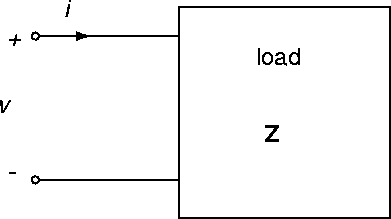




[ENGN2211 Home]
Figure 39:
Load absorbing power.
 |
Consider a load drawing a current i(t)
with voltage v(t) across it, Figure 39.
If v(t) and i(t) are periodic waveforms
with period T, the instantaneous power
is
p(t) = v(t) i(t) .
It is also a periodic function.
The average power
is
(the average over one period).
If
then
 and
and
 |
(49) |
Real AC power is one half the product of the voltage and current
magnitudes times the cosine of the angle between the voltage
and current phasors.
If
and
we can write
 |
(50) |
 is called the power factor angle,
and
is called the power factor angle,
and
 is called the power factor.
is called the power factor.
Note that P is the real power absorbed by the load.
The power P is a maximum when the power factor is 1,
or  ,
i.e. the current and voltage are
in phase.
,
i.e. the current and voltage are
in phase.





[ENGN2211 Home]
ANU Engineering - ENGN2211


![]() ,
i.e. the current and voltage are
in phase.
,
i.e. the current and voltage are
in phase.